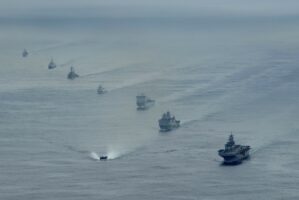17 May 2021
“As a final act of expert planning and coordination about 9,000 military members from several @NATO nations converged on one spot in the North Atlantic today,”
— U.S. Navy (@USNavy) May 18, 2021
– #USNavy Capt. Darren Nelson
READ MORE ?:https://t.co/PFiVwwezFq #NavyPartnerships @RoyalNavy pic.twitter.com/lSAVTssOqX
From a theme we’re following. Training exercises in the Arctic and Northern waters are becoming increasingly common. This joint maneuver is a flag waver for NATO but it demonstrates abilities not seen since WWII of protecting shipping assets on an important link in the global supply chain. Amphibious landings are an interesting addition to the NATO training roster.
Top security experts recently warned that Russia’s plan to remain the sole Arctic superpower is “worrisome and troublesome” and argued that ambition has economic and military implications far into the North Atlantic and Pacific oceans.
From IWOARG Public Affairs – Two Major North Sea Maritime Exercises Converge
The exercises brought together 15 ships from four NATO countries, including the United Kingdom Carrier Strike Group and the U.S. IWO Amphibious Ready Group (ARG) with the embarked 24th Marine Expeditionary Unit (MEU).
The concurrence of Strike Warrior and Ragnar Viking demonstrates the Alliance’s ability to coordinate Carrier Strike Group and ARG/MEU operations simultaneously. These maritime operations illustrate what makes NATO the most successful alliance in history.
“HMS Queen Elizabeth and the USS Iwo Jima represent a substantial concentration of maritime-based air power. With the involvement of warships from four NATO members, including HMS Albion, our rendezvous in the North Atlantic demonstrates the collective strength of the Alliance,” said Royal Navy Capt. Angus Essenhigh, commanding officer, HMS Queen Elizabeth (R 08). “The fact that the Royal Navy is able to deploy a Littoral Response Group and a Carrier Strike Group simultaneously is also significant. Very few other navies can do this, and it underscores the United Kingdom’s substantial and enduring commitment to the security of Europe and the North Atlantic.”
ATLANTIC OCEAN (May 17, 2021) A CH-53E Super Stallion helicopter, left, attached to Marine Medium Tiltrotor Squadron (VMM) 162 (Reinforced) and an MH-60S Sea Hawk helicopter from the “Chargers” of Helicopter Sea Combat Squadron (HSC) 26 fly alongside the Wasp-class amphibious assault ship USS Iwo Jima (LHD 7) during a photo exercise, May 17, 2021. Iwo Jima is underway in the Atlantic Ocean with Amphibious Squadron 4 and the 24th Marine Expeditionary Unit (MEU) as part of the Iwo Jima Amphibious Ready Group. (U.S. Navy photo by Mass Communication Specialist 3rd Class Larry Darnell Lockett Jr.)
Exercise Strike Warrior involves more than 20 warships, three submarines and 84 aircraft from 11 nations and is a final test for the Carrier Strike Group ahead of its first operational deployment to the Mediterranean, Indian Ocean and Asia Pacific.
“As a final act of expert planning and coordination about 9,000 military members from several NATO nations converged on one spot in the North Atlantic today,” said U.S. Navy Capt. Darren Nelson, commodore, Amphibious Squadron Four. “There is simply no substitute for U.S. presence in Europe and the ARG/MEU remains committed to support our allies and partners with our flexible maneuverable force ready to meet emerging missions or contingencies, humanitarian crisis, reassure our partners, enhance security, and ensure the free flow of commerce in the region.”
Ragnar Viking is a multilateral operational exercise exhibiting High-end NATO cohesion, solidarity, and credibility in the Norwegian, North, and Baltic Seas. Ragnar Viking demonstrated long-range strike capabilities from the North Atlantic into Lithuania, amphibious landings in Norway and anti- submarine warfare, and surface action group operations to control the sea, air, and undersea domains, while projecting power.
Ragnar Viking Participating Units include: Iwo Jima Amphibious Ready Group, 24th MEU, USS New Mexico, USS Ross, USS Arleigh Burke, Royal Navy HMS Lancaster and HMS Albion, French Navy FS Normandie and Norwegian Navy HNoMS Sjkold, HNoMS Otto Sverdrup, along with U.S. Navy, U.S. Marine Corps, and U.S. Air Force aircraft. Poland and Lithuania are also supporting the exercise, demonstrating the collective power of NATO to operate in the dynamic maritime environment.
The IWOARG consists of the Wasp-class amphibious assault ship USS Iwo Jima (LHD 7), Harpers Ferry-class dock landing ship USS Carter Hall (LSD 50), and the amphibious transport dock ship USS San Antonio (LPD 17). Embarked detachments for the IWOARG include Amphibious Squadron (PHIBRON) Four, Fleet Surgical Team (FST) Six, Helicopter Sea Combat Squadron (HSC) 26, Tactical Air Control Squadron (TACRON) 21, Naval Beach Group (NBG) Two, Beach Master Unit (BMU) Two, Assault Craft Unit (ACU) Two and Four, and Sailors from Amphibious Construction Battalion (ACB) Two.
The 24th MEU mission is to provide the United States with a forward-deployed, amphibious force-in-readiness capable of executing missions across the full spectrum of combat and military operations other than war and consists of four basic elements – a command element, a ground combat element, Battalion Landing Team (BLT) 1/8, a logistics combat element, Combat Logistics Battalion (CLB) 24, and an aviation combat element, Marine Medium Tiltrotor Squadron (VMM) 162 Reinforced.
